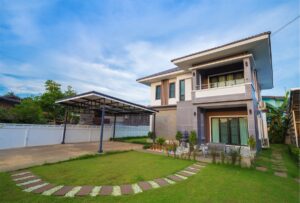Planning to buy a home for the first time? Whether it’s an HDB or a private property, there’s a lot of things to consider — from the location of your new home to the type of home loan to get. While looking up on home loans in Singapore, you might have come across various terms such as SIBOR, fixed deposit rate, SORA and board rate.
Essentially, SIBOR, fixed deposit rate, and board rate are all interest rate benchmarks used by banks in Singapore to price home loans. As they can increase and decrease over time, they’re all considered floating rate. This also means that your monthly instalments will change according to the interest rate charged. Let us dive deeper into what each term means and their differences.
What is SIBOR?
SIBOR stands for Singapore Interbank Offered Rate. It refers to the daily projected rate that banks in Singapore might borrow from each other via the interbank market.
One main aspect of SIBOR is that it’s an average rate derived from the projected borrowing rates submitted by various banks in Singapore. So it’s not influenced by any single bank.
This makes SIBOR one of the most transparent interest rate indexes. It’s also why SIBOR-pegged home loans are pretty popular.
Read this article as we explain more about SIBOR.

What is SORA?
SORA, or Singapore Overnight Rate Average is an alternative benchmark interest rate derived from the average rate of all interbank lending transactions.
It’s calculated based on the volume-weighted average rate of borrowing transactions in the unsecured overnight interbank market made between 8 am and 6:15 pm of each working day.
The rate is published the following day at 9 am on the MAS website.
Find out more about SORA and why it’s replacing SIBOR here.
What is a fixed deposit rate?
As the name suggests, fixed deposit rate refers to the interest rate earned in fixed deposit accounts.
But it’s not only used to determine how much banks give payouts to their fixed deposit customers. In Singapore, a fixed deposit rate is also used by some banks to price home loans, with DBS being the first to do so in 2014.
Called the Fixed Deposit Home Rate (FHR) by DBS, the interest rate for these home loans is based on the average fixed deposit rate over a period of time. A home loan pegged to FHR6 means that it’s pegged to the 6-month average fixed deposit rate.
It works on the idea that if the bank increases the interest rate for the home loans, it will also need to raise the interest rate for their fixed deposit accounts. While it leads to an increase in payouts for the customers, it also translates to higher costs for the bank.
When the banks revise their fixed deposit rates, the loans that are pegged to the rates will be affected. However, there is little impact on ‘existing’ fixed deposit holders as their deposit will only be affected by the change when their fixed deposits mature or due for renewal. We have seen many other banks offering similar products a few years later, albeit with different names.
Not only are the interest rates low, fixed deposit rates are pretty stable as well. Since banks don’t change their fixed deposit rates as much, there isn’t much volatility.
On the other hand, a fixed deposit rate is still considered a type of board rate. Ultimately, it’s still entirely determined by the bank.
Learn more about fixed deposit rates in this article
What is board rate?
Board rate is the bank’s own rate. Since the individual bank determines it, it has full control of it.
For instance, if you’re taking a home loan that is pegged to the board rate and the banks decide to change it, they’ll only give you a 30-day notice before charging you with the different interest rate.
And unlike SIBOR and fixed deposit rates, banks in Singapore don’t reveal how they determine their board rates. Due to this lack of transparency, home loans pegged to board rates are less popular.
What’s the difference between SIBOR, SORA, fixed deposit rate, and board rate?
Now that we’ve explained what SIBOR, SORA, fixed deposit rate, and board rate mean, let’s explore their differences.
Their differences can be broken down into 3 aspects – calculation method, volatility, and transparency.
Calculation method
SIBOR, fixed deposit rate, and board rate all differ in the way they’re derived.
SIBOR is calculated by the Association of Banks in Singapore (ABS) based on interbank borrowing rates.
On the other hand, SORA is derived based on the average rate of all interbank lending transactions. It is governed by the Monetary Authority of Singapore (MAS).
As for fixed deposit rate and board rates, they are determined by individual banks in Singapore. But what sets the fixed deposit rate apart from the board rate is that the former is based on the interest rate for fixed deposit accounts.
Volatility
SIBOR, SORA, fixed deposit rate, and board rate are all types of floating rate. As they can go up and down over time, they’re seen to be less stable than the fixed rates. On the other hand, they differ in the extent of volatility.
Fixed deposit rate is considered the most stable among the 3 benchmarks as banks in Singapore don’t change their rates. While it moves in tandem with SIBOR, it doesn’t increase or decrease as much.
In contrast, SIBOR is more volatile than fixed deposit rate, as it depends on the daily projected rate of interbank borrowing in Singapore.
In the case of home loans, the interest rate can change every month if your home loan is pegged to the 1-month SIBOR. If it’s pegged to the 3-month SIBOR, the interest rate varies every 3 months.
At the end of the spectrum is the board rate. Since the bank has full control over when it wants to change the interest rate, it’s deemed to be the most volatile of the 3 floating-rate benchmarks.
As for SORA, it’s deemed to provide more stability as it’s backward-looking and calculated based on actual transactions.
What does it mean for your home loan?
Whether your home loan is pegged to SIBOR, SORA, a fixed deposit rate or board rate, one downside to its volatility is that you never know exactly how much you’re paying for your upcoming monthly instalments until you get the bill. This can make it harder to plan your financials.
And when interest rates are increasing, you’ll need to pay more for your monthly instalments.
On the flip side, having a floating rate home loan is useful when interest rates decrease, which is what’s happening now. This also means that you can enjoy lower monthly instalments.
Transparency
Among the 3 floating rates, SIBOR and SORA are seen to be the most transparent., they are not influenced by any one bank.
What’s more, the rates are published by ABS (or maintained in the MAS website). They’re open for everyone to see the trend and track the daily rate.
Another interest rate benchmark that’s pretty transparent is the fixed deposit rate. While the individual bank determines it, it’s advertised together with fixed deposit accounts.
This means that you’ll have an idea of how much interest rate will be charged for home loans pegged to the fixed deposit rate.
On the other hand, most banks don’t publish their board rates. Usually, you’ll only know their rates when you enquire them.
This table summarises the differences between SIBOR, fixed deposit rate, and board rate:
| SIBOR | Fixed deposit | Board rate | SORA | |
|---|---|---|---|---|
| How is it derived? | Based on the projections of interbank lending rates | Based on fixed the deposit rate of the bank | Bank’s own rate | Based on actual interbank SGD cash market in Singapore |
| Who is it governed by? | ABS | Individual bank | Individual bank | MAS |
| How volatile is it? | Quite volatile | Less volatile | Most volatile | Less volatile |
| How transparent is it? | Quite transparent | Quite transparent | Least transparent | Most transparent |

Should you choose SIBOR, fixed deposit rate, SORA or board rate for your home loan in Singapore?
If you value transparency and don’t mind a bit of volatility, a SIBOR or SORA-pegged home loan may be the most suitable loan for you.
But if you prefer a more stable rate, a fixed deposit rate home loan may be better.
Board rates may actually be cheaper than any other rates. But no one knows when the bank decides to change it. So you should only go for it if you believe that the bank will not increase it suddenly.
Nevertheless, regardless of the floating rate you choose for your home loan, banks can still control the interest rate they want to charge using the spread. This also means that they can increase the interest rate by increasing the spread.
So the interest rate for your home loan would look like this:
SIBOR, SORA, fixed deposit rate, or board rate + spread = final interest rate
Let’s say you choose to take out a fixed deposit rate home loan. If the fixed deposit rate is 0.2% and the spread is 1.6%, the final interest rate for your home loan will be 1.8%.
So before you choose to take a home loan pegged to either SIBOR, SORA, fixed deposit rate, board rate, or even fixed rate, be sure to take into account their differences, as well as interest rates and spread.
Alternatively, consider engaging a loan broker who can help get the right home loan for you.

At FinanceGuru, we seek to help homeowners find the best home loan and help them achieve their financial goals. Learn more about how you can optimise your home loan and uncover potential ways to save you money and time. Get a non-obligatory assessment and loan product recommendations today.







